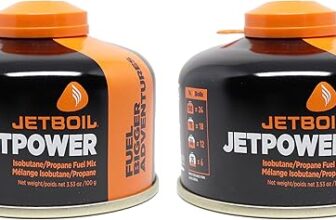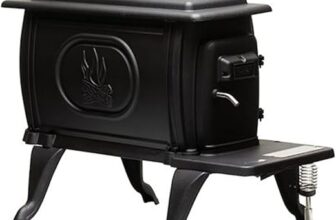
This step-by-step guide on using a portable camping stove provides essential tips for outdoor cooking, helping campers and enthusiasts prepare meals conveniently and effectively. It covers key aspects such as setting up the stove safely, selecting appropriate cookware, managing fuel types, and understanding cooking techniques specific to camping. By following these instructions, you’ll be equipped to cook delicious meals in the great outdoors, enhancing your camping experience.



Affordable Homemade Camp Stove
Choose the Right Portable Camping Stove
Assess your cooking needs by evaluating the types of meals you plan to prepare. Identify the size of the stove that will fit in your camping gear while accommodating your cooking style. Explore various fuel types such as propane, butane, or wood, and choose one that aligns with your preferences and the convenience of your camping location. Consider the number of burners you need based on the size of your camping group and the complexity of the dishes you want to create. Investigate user reviews and product specifications to ensure you select a stove that is reliable and straightforward to operate.
Gather Necessary Cooking Equipment
Gather the essential cooking utensils and equipment for your culinary adventure. Include a variety of pots and pans, such as a medium-sized saucepan and a frying pan to handle different cooking tasks. Use sturdy cooking utensils like spatulas, wooden spoons, and tongs for efficient food preparation and serving. Pack matches or a lighter for igniting your cooking stove, and ensure you have an appropriate fuel source, whether it’s propane, charcoal, or wood, depending on your cooking method. Keep everything compact by using nesting pots and stacking pans, making it easy to carry all your gear in a durable, portable bag.
Set Up Your Camping Stove
Choose a flat, stable surface for your camping stove, ensuring it’s at least three feet away from any flammable materials like tents, dry grass, or firewood. Position the stove on a picnic table or a level patch of gravel rather than on a grassy area, where it can be unstable.
Follow the manufacturer’s instructions closely to assemble the stove, referring to the included manual for specific steps and parts. Securely attach the fuel source, whether it’s a propane canister or liquid fuel, making sure it is properly aligned and tightened to prevent leaks. Check the connection by gently twisting the fuel source in place until you feel it lock, ensuring there is no wobbly movement.
Check Safety Features
Check for flame control features to ensure that you can easily manage the intensity of your heat. Inspect the stove for stability, making sure it is on a level surface and securely positioned to prevent tipping. Confirm that there is adequate ventilation in the cooking area, such as opening windows or using an exhaust fan, to avoid the buildup of harmful fumes. Read and familiarize yourself with the stove’s safety guidelines provided in the user manual to understand all safety protocols and operating procedures.
Light the Stove
- Choose a match or lighter that is suitable for igniting gas burners. Ensure it is long enough to keep your hands away from the flame.
- Position the flame source near the burner while holding the lighter or match at arm’s length.
- Follow the specific lighting instructions provided with your camping stove, which may include adjusting the gas flow before ignition.
- As you ignite the burner, keep your face and body away from the flame to prevent any accidents.
- Once lit, adjust the flame to your desired heat level using the stove’s control knob.
Adjust the Flame
Adjust the flame to achieve optimal cooking temperatures. Choose a higher flame for boiling water, which allows pasta to cook quickly and efficiently—turn the knob to the right until the flame reaches a vigorous level. For simmering sauces or soups, lower the flame until it gently bubbles, keeping the mixture warm without burning—decrease the knob’s setting to the left to create that gentle heat. Experiment with the flame levels to find your preferred cooking speeds and results for different dishes.
Cook Your Meal
Place your cooking pot or pan on the burner and select the appropriate heat level for your recipe. Begin cooking your meal by adding your ingredients; be sure to stir frequently to ensure even cooking. Monitor the cooking process closely, adjusting the heat as needed to prevent food from burning or sticking to the bottom. Check the texture and doneness of your meal regularly, and add any additional seasonings as desired.
Monitor Cooking Time
- Set a timer when beginning to cook. This ensures you won’t lose track of time, especially with dishes that require precise cooking.
- Adjust timer settings according to specific recipes. Different dishes have varying cooking times, so tailor your timing for optimal results.
- Check on your food periodically as it cooks. While using a timer is helpful, visual inspection can prevent overcooking.
- Take notes on cooking times for future reference. Keeping a log can help you perfect your technique over time and prevent mistakes.
Turn Off the Stove
Turn off the stove by adjusting the flame control to the off position. Ensure that all burners are completely extinguished before leaving the kitchen. Wait for the stove to cool down completely to avoid burns or injuries. Once cooled, disassemble any removable parts as needed and store them safely for future use.
Ready for Your Adventure!
In conclusion, using a portable camping stove can significantly elevate your outdoor adventures by making meal preparation simple and enjoyable. By adhering to the essential safety tips and cooking techniques outlined in this guide, you can ensure a pleasant and efficient cooking experience. Whether you’re in the mountains or by a serene lake, a portable stove empowers you to enjoy hearty, home-cooked meals while immersed in nature. Happy cooking and safe travels!
Essential Gear List

Maximize Your Cooking Experience
Step-by-Step Guide to Efficient Cooking on the Go
- Read the Manual: Before using your portable camping stove, read the manufacturer’s instructions carefully to understand its features, safety precautions, and assembly requirements
- Choose a Suitable Location: Set up your stove on a flat, stable surface away from flammable materials. Ensure the area is well-ventilated and free of any wind that could blow flames or hot materials
- Fuel and Setup: Make sure you have the correct fuel type for your stove (propane, butane, etc.). Attach the fuel canister securely and check for leaks before igniting the stove
- Igniting the Stove: Follow the ignition procedures as outlined in the manual. Use a long lighter or match to ignite the burner and adjust the flame to the desired heat level
- Cooking Safely: Always supervise the stove while in use, and use cookware that is compatible with your stove. Be cautious of hot surfaces and turn off the stove when finished cooking. Let it cool down before packing it away
Common Questions About Portable Camping Stoves
Yes, there are portable camping stoves that are eco-friendly and utilize renewable energy sources. These stoves often utilize solar power, biofuels, or are designed to be efficient with minimal emissions.
- Solar-powered stoves: These stoves harness sunlight to cook food and are especially effective on sunny days. They can be an excellent option for campers seeking to reduce their carbon footprint.
- Biofuel stoves: Some portable stoves operate on biofuels, such as wood pellets or other organic materials. These stoves can often burn cleanly and are designed to minimize smoke emissions.
- Efficient propane or butane stoves: While not entirely renewable, many modern propane or butane camping stoves are designed for higher efficiency, reducing fuel consumption and greenhouse gas emissions.
- Wood-burning stoves: These stoves utilize natural wood as fuel and can be efficient if sourced responsibly. They are designed to burn wood cleanly and generate less smoke than traditional open fires.
When choosing an eco-friendly camping stove, it’s essential to consider factors such as efficiency, emissions, and the type of fuel used. Always check for certifications or labels that indicate environmental standards to ensure you make a sustainable choice.









Hey, I just got a Coleman Fold N Go portable stove for my camping trips! It’s so easy to set up and use. Just wondering if anyone else has tried it and what recipes you recommend for it?
What’s the best way to check if the stove’s safety features are working properly? I always get nervous about using propane canisters in the wild.
Great question! Always check for leaks by applying soapy water to the connection points. If there are bubbles, it’s leaking. Make sure to test everything before you head out!
Does anyone have a favorite camping recipe that doesn’t require a lot of ingredients? I’m trying to pack light but still want to eat good!
Absolutely! Try foil packet meals. Just wrap your veggies and protein in aluminum foil with some seasoning and cook them on the stove. Super easy and delicious!
I think using a portable stove is safer than cooking over an open fire, but I’ve heard mixed opinions. What do you all think? Anyone had a bad experience with one?
It really depends on how you use it! Portable stoves can be safer due to controlled flames, but always prioritize safety and follow guidelines. Let’s keep the conversation going!
I’ve had some trouble lighting my stove in windy conditions. Any advanced tips for getting it to light faster when the wind is blowing? I hate wasting matches!
I’ve been using a Jetboil Flash for quick meals while hiking. Anyone have tips on how to make the best use of it for group cooking? Seems like it’s mostly for solo meals.
Just used this guide to cook a one-pot pasta dish on my MSR PocketRocket, and it turned out awesome! The setup was super simple, and I loved how quickly it boiled water.
That’s fantastic to hear! One-pot meals are perfect for camping. What ingredients did you use? I’m always looking for new ideas!
I’m really interested in the environmental aspects of using a camping stove. Can anyone share the best practices for cleaning up and being eco-friendly while cooking in nature?